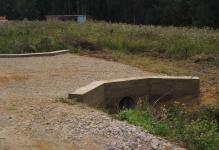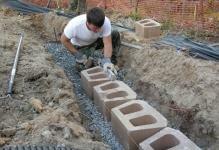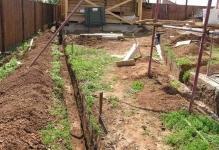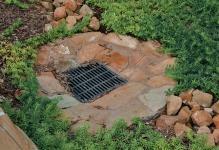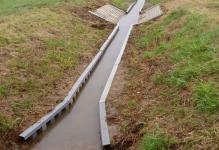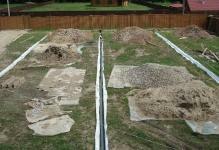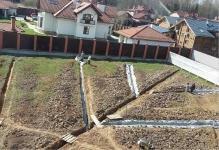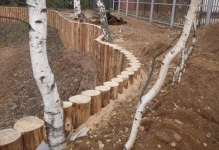 Geogrid - a modern material for strengthening the soil Slopes and edges of drainage ditches are the most unsafe places in the suburban area and they require special fixation. Especially this applies to the slope at the foot of the house, the precipitation may begin to wash the soil from under the foundation, which can lead to undesirable consequences.
Geogrid - a modern material for strengthening the soil Slopes and edges of drainage ditches are the most unsafe places in the suburban area and they require special fixation. Especially this applies to the slope at the foot of the house, the precipitation may begin to wash the soil from under the foundation, which can lead to undesirable consequences.
-
- How to strengthen a ditch: basic methods
- Drainage ditch: features of the
- Drainage grid for strengthening the slopes
- How to level the ditch with slate: step-by-step instruction
- Install geogrid for strengthening the slopes( video)
- Examples of ditch reinforcement in the suburban area( photo)
How to strengthen a ditch: the basic methods of
If a dacha or country house is located in a terrain with a complex terrain,denie soil or snow debris from the top point. Very often during the rains down the slope drains dirt, leaves, roots.
Rain streams or melting snow can damage the flower beds or planting of plants below. To avoid such problems, you need to strengthen the slope.
In general, the need to strengthen the slope occurs in the area with mountain ranges, ravines and in the forest.
 Geogrid does not allow moisture penetration and therefore will not allow soil to slip during rain or snow melt
Geogrid does not allow moisture penetration and therefore will not allow soil to slip during rain or snow melt
Slope consolidation methods:
- Bushes and flower beds. To strengthen the slope, plants with a well-developed root system are often planted. Suitable are perennial plants such as cedar or pine, lilac, hawthorn, blackberry bushes and raspberry, tree-like peonies. Effective when the soil slope is up to 8 degrees.
- Support in the form of a fence of brick or concrete slabs. Fences are durable, do not interfere with the growth of flowers and bushes. You can decorate the fence with a flower bed of flowers or street lamps.
- Strengthening with large stones. On the slope are laid out large boulders, which will detain the soil from shedding. You can also use decorative logs, dug into the ground.
- Biomats. Suitable for strengthening the slopes up to 70 degrees. The materials are superimposed on the surface cleared of large stones and fixed at the edges. Throughout the perimeter plant seeds are planted, which germinate and adhere to the fibers of the mat.
- Geotextiles, geomes and geonet. Work on one principle - they are laid on the surface, form an even layer.
The choice of material for strengthening the soil depends primarily on the angle of the earth and its area. Work with the design of slopes does not require special skills, but it is recommended to approach the design clearly and seriously in advance to make calculations of the necessary amount of material and fasteners.
Drainage Ditch: Features of the
During high rainfall or frequent rains, water that accumulates on the surface accumulates on the site. Because of underground groundwater, precipitation does not absorb into the soil, so you need to look for a way to drain the surface. One of the available and effective methods of draining the soil is a drainage ditch.
The drainage trench system is often used in areas with a minimal slope, where after the rain the water stagnates constantly.
 In order to lay a drainage ditch, it is necessary to determine where the water flows, that is, to find the slope on the site
In order to lay a drainage ditch, it is necessary to determine where the water flows, that is, to find the slope on the site
. For areas with a strong bias, drainage will help prevent displacement of fertile soil and washing away the growing plants in the cottage.
To strengthen the ditch in the country, you can use the most common car tires, cut into several parts. Each part fits into a ditch, forming a U-shaped pipe. It will drain excess water.
Drainage grid for strengthening slopes
Drainage mesh is a lattice made of polymeric material with diamond shaped cells, which provides surface strengthening and a good outflow of water. The material from which the mesh is made does not rot, it is not afraid of garden pests and other microorganisms.
Depending on the field of use, the mesh protects the surface from large debris - leaves, twigs and lumps of dirt.
To strengthen the slope, a geomat is used, which includes a drainage grid framed by layers of geotextile. The mat is firmly fixed to the surface, holding the slope away from destruction.
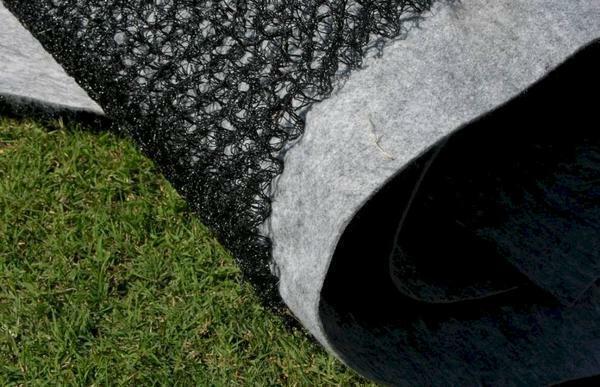 One of the main advantages of the geomat is the flexibility and ease of the material
One of the main advantages of the geomat is the flexibility and ease of the material
Advantages of the drainage mat:
- The slopes are reinforced firmly and for a long time;
- Easy to install and does not require special tools;
- Well tolerates temperature changes;
- Not afraid of fungus and does not rot;
- Environmentally friendly material.
Drainage mats are used both for strengthening the soil on slopes, and in construction work - protecting the foundation and the basement from underground groundwater. Also used mat to strengthen roadsides on highways and steep slopes on sports grounds and stadiums.
How to level the ditch with slate: step by step instruction
Many summer residents have determined that the simplest and most economical way to strengthen the walls of the drainage ditch is to protect its walls with slate.
Strengthening the slopes with slate is a short-lived and not very attractive external fence, but, despite the shortcomings, it does its job well.
For laying slate along the ditch you will need a Bulgarian, a respirator, a shovel and metal rods.
 The simplest and cheapest way to fix ditches is to place the same pieces of slate along their edges
The simplest and cheapest way to fix ditches is to place the same pieces of slate along their edges
Procedure:
- Cut slate sheets into identical pieces. When cutting slate Bulgarians must use a respirator and glasses to close their face from dust.
- Depending on the angle of the ditch with a shovel, dig in the slate along the walls. Pieces of wavy slate are superimposed on each other, flat - butt.
- So that the slate does not move, fix it on both sides with metal rods. They are driven into the ground to a depth of 50-60 cm.
- It is better to paint rods with paint or anticorrosive compound.
The drainage ditch, along which the water will flow, can be sent to a specially equipped well. Accumulated natural water is useful for watering the garden in a particularly dry season.
Mounting of the geoset for strengthening the slopes( video)
The edges of the ditches and high slopes can be made stable with the help of ordinary slate or car tires, however, for a long-lasting and more lasting strengthening experts advise using geosets, biomats and gabions.
